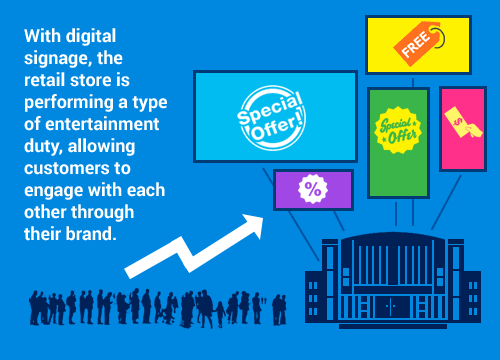Where does Digital Signage fit in Omnichannel Retail?
To the uninitiated, digital signage is nothing more than a fancy-looking screen that provides digital versions of corporate posters and advertisements. This mindset is rather shortsighted and fails to take into account the impact that digital signage can have on the health of your omnichannel retail business.
According to a report by Infiniti Research Limited, the global digital display market is forecasted to show a compound annual growth rate of nearly 15% by 2019. Lots of fancy words, sure, but what this means for retailers is that the growth of retail digital signage is showing no signs of slowing down and businesses who want to stay competitive need to keep up.
The Evolution of Retail Digital Signage
The digitization of the consumer world is well underway. Technological advancements are making it easier than ever to deliver personalized, effective customer outreach. The growth of digital signage from a simple advertising medium to an effective strategy for retail engagement highlights this trend rather well.
Starting with basic information delivery, digital signage quickly expanded. Soon it provided personalized information based on region, time of year, and other demographics. This empowered retailers to segment their market for more customized service.
Digital signage didn’t stop there. With personalization well established, the next logical step was direct customer interaction through kiosks and platforms. Quickly, these were able to proactively address consumer needs.
As the cost-effectiveness, personalization, and flexibility of retail digital signage progressed, it began to take shape as an effective way to drive customer sales, promote brand awareness, and reconcile the customer journey through the transition from digital to physical channels of purchase.
Consumer Digitization and Omnichannel Retail
Increasing reliance on technology has shaped the way consumers view the world. Online purchasing, mobile apps, and social media have created countless new opportunities for consumers to connect to retailers. Millennials know this better than anyone, having been born into an age of developing tech and growing up alongside the evolving channels that now define our communication.
They have already begun to shape marketplace trends with purchasing power that rivals the baby boomer generation. Their preference for mobile options and innovative tech outreach has created unprecedented digitization of the marketplace; data from the 2015 Internet Retailer Mobile 500 report showed that shopping applications alone provided 42% of all mobile commerce.
Brick and mortar businesses must account for this trend by joining the digital experience of their consumers with the experience they find in-person. Conveniently, brand apps that allow mobile shopping, discounts, and personalized outreach are one of the best ways to create an environment that is both customized to the consumer experience and optimized for the digital age.
Understanding the needs of the tech-hungry millennial market is necessary to create in-store shopping experiences that reflect the changing priorities of a younger marketplace.
Bridging the Digital Gap
There’s no denying that physical locations are still essential to business even with the adoption of technology. When Amazon, eBay, and other digital retailers started crossing the multi-million dollar mark, the world took notice. Brick-and-mortar businesses were at risk.
Clearly, this is not the case. A study by A.T. Kearney indicates that traditional shopping still makes up the vast majority of all retail sales. A whopping 90% of all retail sales occur in physical store locations, and 95% of retail sales overall go through businesses that maintain a brick and mortar presence. While the convenience of online retail is hard to beat, the value of an in-person shopping experience may be impossible to replicate.
Retail digital signage can be used to turn a store from “a place where people just go shopping” to a destination for interaction. Social apps may be essential to today’s market of digital users, but replacing in-person socialization with technology has created widespread social isolation. With digital signage, the brick and mortar store is performing a type of entertainment duty, allowing consumers to engage with each other through their brand. This is the experience that increasingly tech-savvy consumers are looking for.
More on the Customer Journey
Digital signage also helps “continue” the customer journey as they transition from digital platforms (apps, websites, mobile) into brick-and-mortar establishments. Think of digital signage as the “face” of a business when customers enter the store. What better way to display unlimited amounts of marketing materials! You can engage an audience with a digital display system that’s as easy to use as a TV screen?
Digital signage offers a way for retailers to get the best of both worlds. You get both flexibility and accessibility of digital data paired with the personal touch of in-store customer service. Your customers are empowered by the instant delivery of product information, tech specs, and retailer discounts. This fusion is essential to providing an omnichannel customer experience.
Omnichannel Retail Outreach
Some venues (we’re looking at you, Times Square) use digital signage merely as a gaudy advertising tool. But savvy retailers view digital sign systems as an essential part of an omnichannel marketing strategy. According to NCR Global Consumer Research, 87% of customers want similar ways to access products and services, regardless if they’re online, on mobile, or in-person at a physical store location. This highlights the importance of finding ways to bridge the gap between online services and the in-store experience.
The 2013 Cisco Customer Experience Report had some pretty compelling points to make about the state of the multichannel shopping experience: 34% of global buyers used more than one channel while shopping, with 23% of consumers having recently made in-store purchases based on online research. 34% percent may not sound like a lot, but consider that we’re talking about global buyers, here. That’s a third of all potential buyers across every industry, every country, and every demographic. Clearly, the digital revolution is here to stay.
Having said all of that, the Cisco report made another interesting discovery. They noted that 58% of shoppers still preferred to receive help from an in-store associate. Technology hasn’t killed physical store locations. And retail digital signage solutions may be the best way to facilitate a transition between the two.
Show off your Omnichannel Retail Brand…
But digital signage is more than just a way to hybridize physical and digital presences. The right implementation of digital signage into a retail strategy can help showcase brand identity and improve customer relationships.
Think about it – how do customers typically interact with a brand? When they’re not shopping in-store, their awareness is limited to digital (and print) advertisements, commercials on TV and radio. This creates a type of “corporate identity” that helps form customer perceptions of a brand. And as we mentioned above, customers need consistency. This makes it necessary for retailers to adhere to the marketing messages and unique advertisements that their audience knows and loves. Data by Samsung indicates that 84% of UK retailers believe that digital signage creates substantial brand awareness – highlighting the importance of maintaining a consistent, digitally-focused brand image to show off the dynamic story of your company.
…And Sell to them Too!
But eye-catching digital signage has value even beyond brand awareness or bridging the digital gap. It can be used to boost service personalization and drive revenue-producing sales—in fact, research revealed that digital signage can add an upswing in overall sales volume of nearly 32%.
How is this possible?
This has to do with how easy it is to interact with digital display systems. You can customize displays to each user. So, guarantee every customer receives a unique experience based on their purchasing history and interests. Some businesses are already doing this with barcode scanning displays for membership cards and loyalty programs. The customer simply has to scan their card at a kiosk to get a personalized display of relevant offers. You can add promotions and membership specials as well. This type of outreach can be significant — the same research quoted above revealed that 29.5% of customers found digital menus and visual displays influential in their purchasing decision.
Finding Value in Omnichannel Retail from Digital Signage
Don’t wait to implement a digital signage strategy in your retail location. Consistency and a fluid customer experience are essential to generating revenue and building a loyal following. However, this experience can be hard to create without a bridge between your physical and digital presence. A retail digital signage strategy may be all your business needs to bring more eyes to your brand. And…bring more people to your store.




